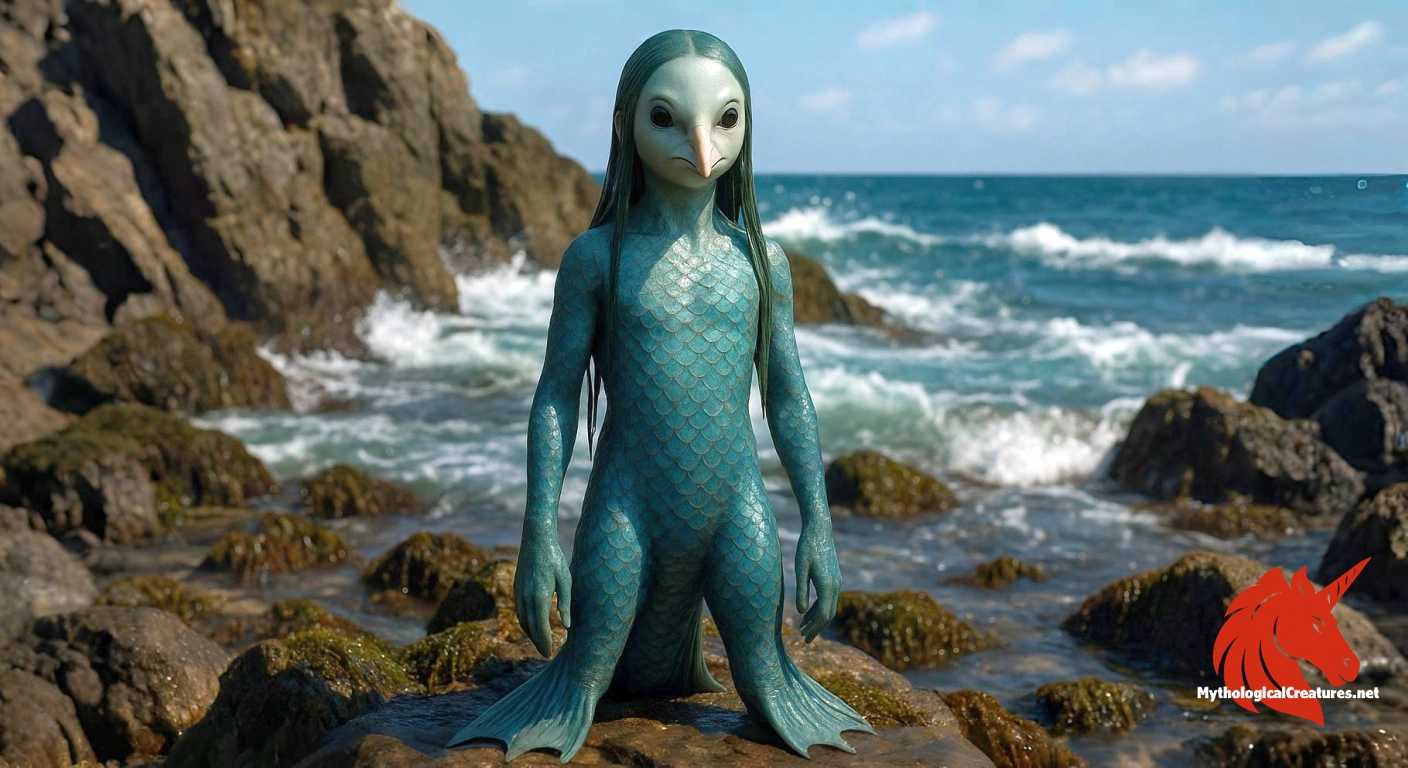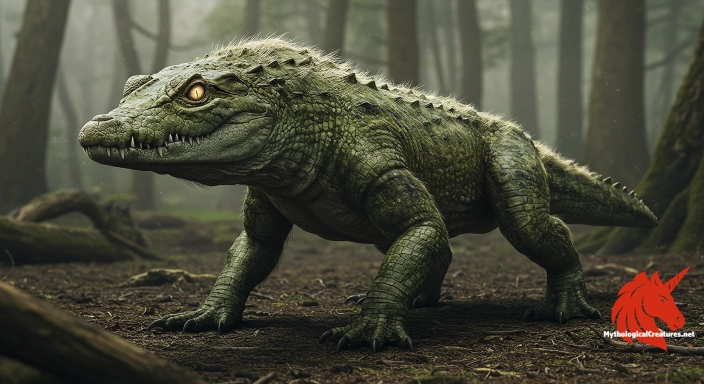Amabie: Amabie is a legendary Japanese mermaid-like creature with a distinctive bird beak-like mouth and three legs or tail-fins.

Amabie
Amabie - Amabie is revered as a prophetic figure whose appearance warns of either bountiful harvests or impending epidemics, with its image used to deflect illness.
Origins & First Encounters
The Amabie is an enigmatic figure from Japanese folklore whose origins have long captivated the imagination. Emerging from a rich tradition of maritime myth, this creature was first recognised in mid-19th century illustrations and pamphlets. Its earliest modern appearance is most notably traced to a woodblock print dated 1846, although similar beings appear under the name Amabiko in earlier records. The creature’s legend intertwines themes of prosperity and warning, promising either an abundant harvest or heralding the spread of illness. Its otherworldly form, half-mermaid and half-animal, set against the backdrop of natural and human disasters, resonated deeply with communities facing uncertain times. Unique in its dual role as both omen and protector, the Amabie reflects a culture keen to blend the supernatural with practical contingencies. Its narrative has been passed down through generations, symbolising the collective hopes and fears of an ever-transforming society. This enduring myth not only illuminates facets of historical public health but also continues to intrigue modern audiences with its mysterious allure.
Source Texts & Tale Variants
Primary records of the Amabie are found within a diverse array of illustrated woodblock prints, surimono pamphlets, and hand-painted leaflets. One of the most influential depictions is a print bearing the date 1846, which has become a central reference for the creature’s iconography. Earlier documentation surfaced with a hand-painted leaflet dated to 1844, hinting at the existence of a variant known as Amabiko. These sources, crafted during a period when visual news bulletins were a key medium of communication, reveal the dynamic circulation of folk lore. Several narrative strands coexist within these records, with some emphasising its role as a harbinger of plentiful harvests while others focus on its ominous warnings of epidemics. The depictions also vary significantly, with differences noted in the number of legs and overall physical form, suggesting local reinterpretations. Such printed artefacts were not only carriers of myth but also instruments to galvanise community response during crises. The variety and richness of these texts continue to shed light on how folklore served as both historical documentation and social intervention.
Form & Powers
The Amabie is portrayed with a striking synthesis of marine and terrestrial features that challenges conventional anatomical forms. Its face is dominated by a prominent, bird beak-like mouth that lends the creature a distinctive, almost avian character. Traditionally, it is depicted with three legs or tail-fins, though some artistic renditions incorporate a fourth limb, adding to the ambiguity of its bodily structure. The body of the Amabie is often rendered with shimmering scales, suggesting a vibrant texture that blurs the line between a fish and a mystical entity. Its head, while retaining subtle human-like elements, exudes an animalistic energy that hints at deeper symbolic powers. Observers may note a fusion of elements resembling both daruma dolls and ape-like forms, which contributes to its puzzling and eclectic appearance. The creature’s limbs, irregularly arranged, enhance its portrayal as a being that defies natural order, exemplifying the unpredictable nature of its prophetic abilities. Intricate patterns and artistic flourishes in various depictions underscore the amalgamation of aesthetics drawn from both the natural and the supernatural. The overall presentation of the Amabie invites viewers to appreciate an art form that is as much about mystery as it is about visual innovation.
Regional Faces
Regional interpretations of the Amabie reveal a fascinating spectrum of local adaptations and cultural nuances. In some parts of Japan, the creature is more commonly known as Amabiko or Amahiko, reflecting subtle regional differences in pronunciation and tradition. Coastal areas, where the sea plays a vital role in daily life, often depict the Amabie as a benevolent sea spirit invoked to protect communities from epidemics. Conversely, inland portrayals can emphasise agricultural overtones, linking the creature to bountiful harvests and the cyclical nature of rural life. These local variants sometimes adjust its visual attributes, such as the number of legs, to align with indigenous artistic styles and symbolic frameworks. In certain regions, the creature’s hybrid nature is further enhanced by incorporating elements reminiscent of daruma dolls or even ape-like characteristics, highlighting local myth-making traditions. These adaptations underscore the fluidity of folklore, where each community reinterprets the Amabie to address its unique environmental and social concerns. Such regional diversity ensures that the creature remains a versatile cultural icon, rich in both meaning and representation. The interplay between local lore and the broader myth of the Amabie demonstrates the dynamic evolution of folklore in response to changing societal contexts.
Cultural Parallels
The Amabie shares intriguing parallels with other mythological figures that straddle the boundaries between the known and the mysterious. Much like the mermaids and sirens of European lore, this creature inhabits a liminal space where the sea and the human world intersect, evoking both allure and caution. However, unlike many of its Western counterparts, the Amabie is especially noted for its prophetic capabilities, serving as an omen that foretells both prosperity and peril. Its unusual blend of marine, avian, and even primate features invites comparisons with composite creatures found across various Asian mythologies, where hybrid forms frequently symbolise the convergence of different natural forces. This multifaceted composition resonates with the global human tradition of portraying supernatural warnings through abstract and often contradictory imagery. The creature’s role as both a harbinger of epidemics and a guardian of community well-being positions it within a wider narrative found in other cultural traditions that use myth to address societal fears. Artistic and cultural reinterpretations over time have further aligned the Amabie with symbols of resilience and transformation seen in diverse mythic traditions. Such cross-cultural connections enrich our understanding of the universal themes underlying myth, underscoring a shared human response to the uncertainties of nature and society.
Legacy & Modern Evolution
The historical trajectory of the Amabie mirrors its transformation from a local folkloric omen to a modern symbol of resilience and hope. Initially emerging in the mid-19th century, its depiction through woodblock prints and pamphlets played a crucial role in communicating warnings during times of epidemic and famine. As Japan modernised, the creature’s image faded from everyday conversation, yet it never entirely disappeared from the cultural imagination. In recent times, particularly during episodes of global health crises, the Amabie has experienced a renaissance in popular culture, reappearing in digital art, social media trends, and even fashion merchandise to evoke communal solidarity. This modern revival interweaves its ancient prophetic role with a contemporary understanding of medicine and public health. Artists and creators have embraced its enigmatic aura, transforming it into a symbol not only of past calamities but also of the human capacity to endure and overcome adversity. The evolution of the Amabie from a 19th-century woodblock image to a widely recognised digital icon illustrates the fluidity of myth in adapting to modern challenges. Its enduring narrative continues to inspire dialogue about the intersection of folklore, art, and collective memory. Today, the Amabie stands as a testament to the power of traditional myth to offer comfort and hope in the face of modern uncertainty, bridging centuries of human experience.
Interesting Fact
An interesting facet of Amabie's legacy is that during times of epidemics, reproducing its image became a communal ritual believed to protect entire communities from disease.
Quick Creature Info
Features:
Associations:
Our Mythic Legendary Rating:

Also Sometimes Known As:
Habitat:
Supernatural Powers:
Physical Attributes:
Abilities:
Behavior:
Lore:
Related Creatures, Tales or Lore
- AAmabiko
- AAmahiko-nyudo
- NNingyo
References
Discover Another Mythical Legend You May Not Have Heard Of?
Uncover the mysteries of ancient folklore and expand your knowledge of legendary beings from cultures around the world.
Dare to Meet the Afanc....
Mythical Disclaimer: The images and data on this site are derived from various historical and literary sources, but we have found that many myths often have multiple versions and interpretations across references, sometimes contradictory. As a result, these creature depictions are artistic interpretations—imaginative blends of folklore, legend, and a dash of AI guesswork. Because creature descriptions vary widely, our illustrations and accompanying information represent our best effort to honor mythology while bridging creative gaps. Enjoy these interpretations—just remember, we've done our best to respect the stories and validate available data, but in the realm of mythology, details often shift, imagination leads the way, and nothing is ever set in stone!
Curated by the Mythological Creatures Team (rev. May 2025)
